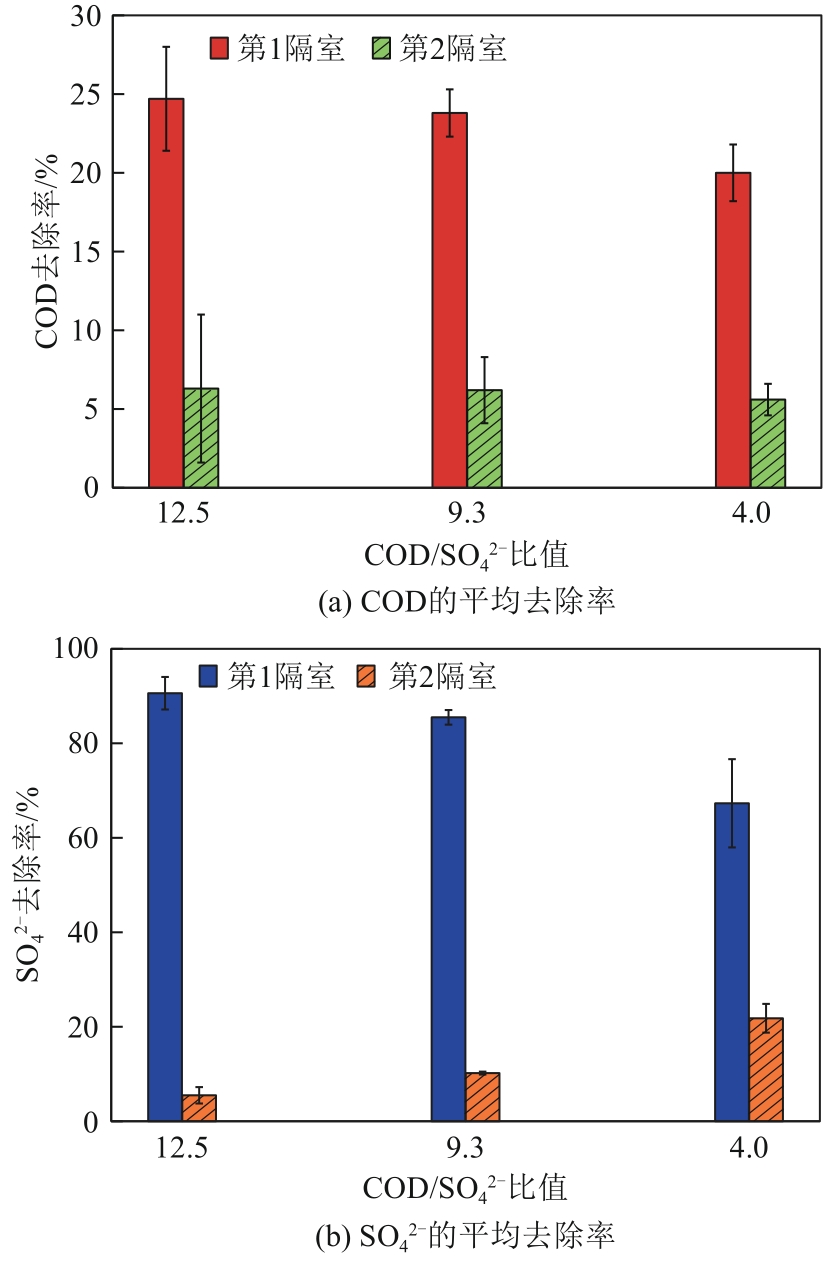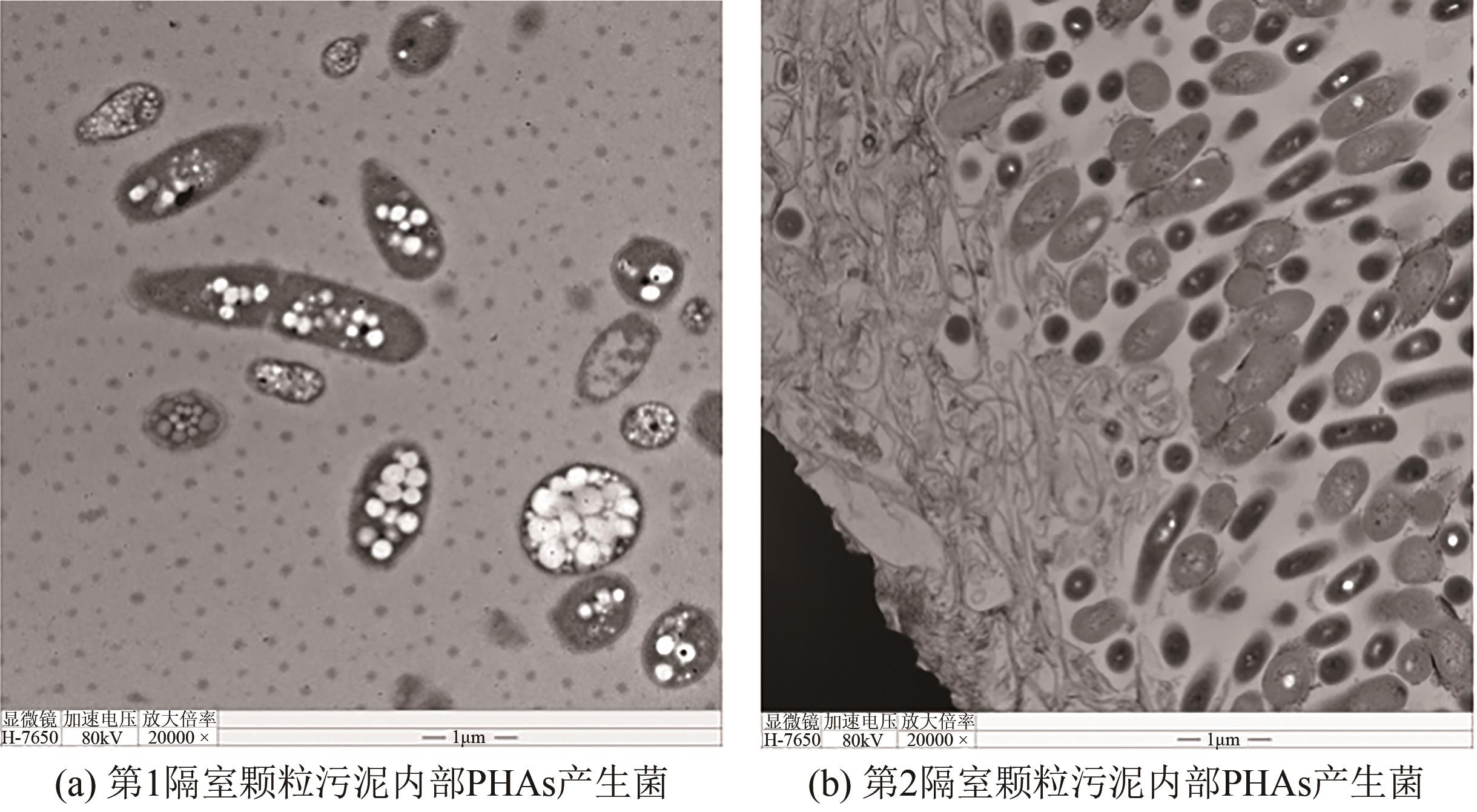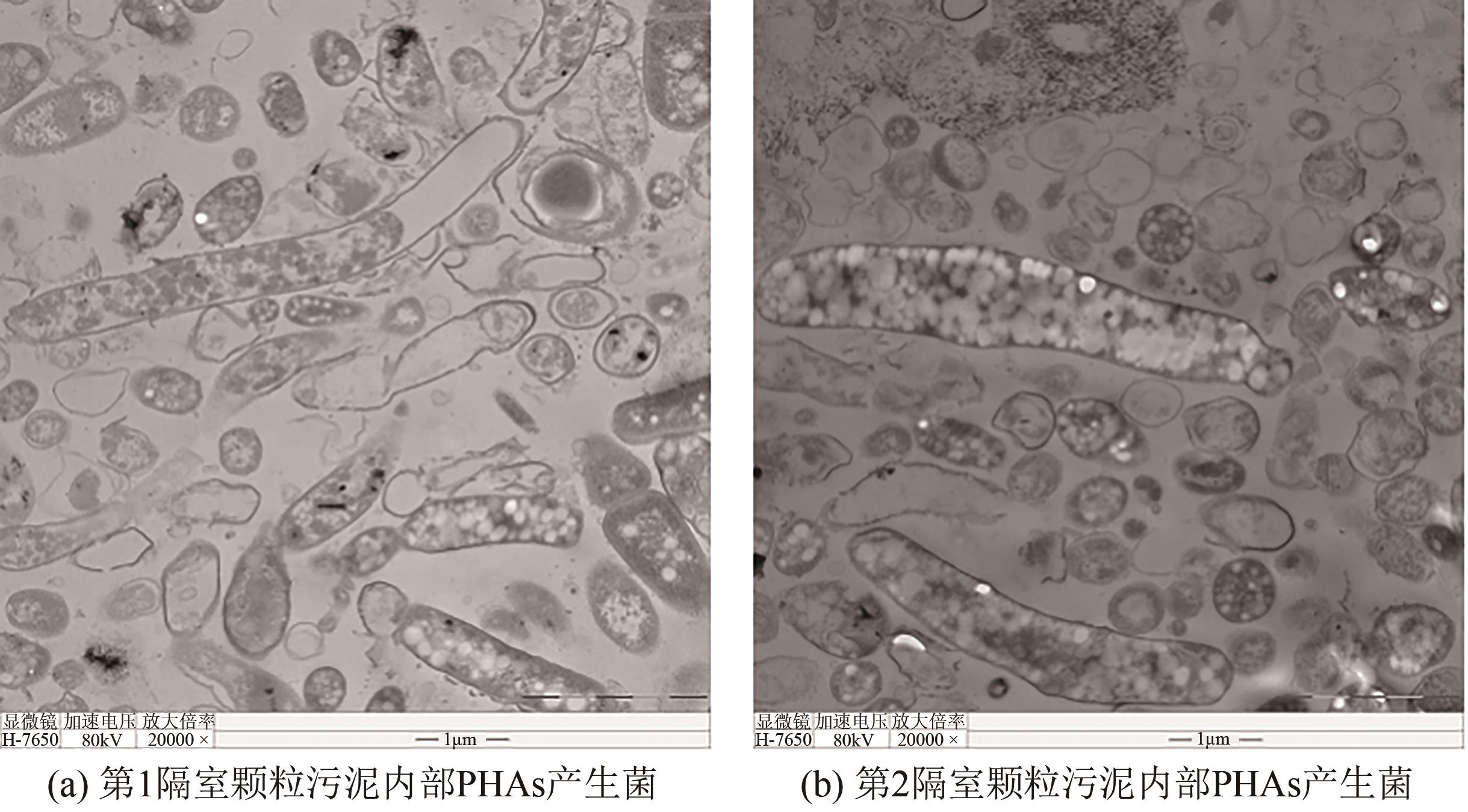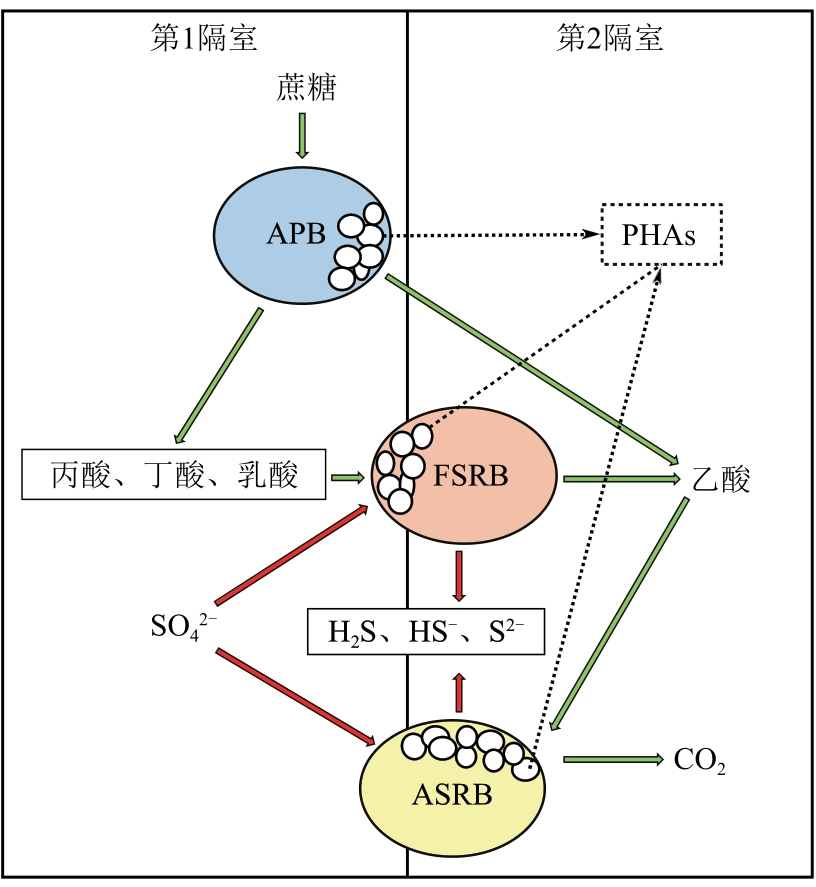Chemical Industry and Engineering Progress ›› 2023, Vol. 42 ›› Issue (12): 6658-6665.DOI: 10.16085/j.issn.1000-6613.2023-0203
• Resources and environmental engineering • Previous Articles
Enrichment of PHAs-producing bacteria by granular sludge in ABR acidogenic sulfate-reducing phase
WANG Chenxiang1( ), QIN Yongli1, JIANG Yongrong1(
), QIN Yongli1, JIANG Yongrong1( ), GE Shijia1, ZHENG Guoquan1, SUN Zhenju2
), GE Shijia1, ZHENG Guoquan1, SUN Zhenju2
- 1.College of Life and Environmental Science, Guilin University of Electronic Technology, Guilin 541004, Guangxi, China
2.School of Engineering, Westlake University, Hangzhou 310030, Zhejiang, China
-
Received:2023-02-16Revised:2023-03-17Online:2024-01-08Published:2023-12-25 -
Contact:JIANG Yongrong
ABR产酸-硫酸盐还原相颗粒污泥富集PHAs产生菌
汪晨祥1( ), 秦永丽1, 蒋永荣1(
), 秦永丽1, 蒋永荣1( ), 葛仕佳1, 郑国权1, 孙振举2
), 葛仕佳1, 郑国权1, 孙振举2
- 1.桂林电子科技大学生命与环境科学学院,广西 桂林 541004
2.西湖大学工学院,浙江 杭州 310030
-
通讯作者:蒋永荣 -
作者简介:汪晨祥(1998—),男,硕士研究生,研究方向为污水生物处理及微生物学。E-mail:328232536@qq.com。 -
基金资助:国家自然科学基金(52060004);广西高校中青年教师科研基础能力提升项目(2021KY0204)
CLC Number:
Cite this article
WANG Chenxiang, QIN Yongli, JIANG Yongrong, GE Shijia, ZHENG Guoquan, SUN Zhenju. Enrichment of PHAs-producing bacteria by granular sludge in ABR acidogenic sulfate-reducing phase[J]. Chemical Industry and Engineering Progress, 2023, 42(12): 6658-6665.
汪晨祥, 秦永丽, 蒋永荣, 葛仕佳, 郑国权, 孙振举. ABR产酸-硫酸盐还原相颗粒污泥富集PHAs产生菌[J]. 化工进展, 2023, 42(12): 6658-6665.
share this article
Add to citation manager EndNote|Ris|BibTeX
URL: https://hgjz.cip.com.cn/EN/10.16085/j.issn.1000-6613.2023-0203
| VFAs | COD/SO42-=12.5 | COD/SO42-=9.3 | COD/SO42-=4.0 | |||
|---|---|---|---|---|---|---|
| 第1隔室 | 第2隔室 | 第1隔室 | 第2隔室 | 第1隔室 | 第2隔室 | |
| 乙酸/mg·L-1 | 414(29%) | 894(69%) | 462(28%) | 1056(73%) | 420(22%) | 696(34%) |
| 丙酸/mg·L-1 | 215(15%) | 140(11%) | 251(15%) | 96(7%) | 200(11%) | 185(9%) |
| 丁酸/mg·L-1 | 659(46%) | 255(20%) | 774(48%) | 299(20%) | 994(54%) | 941(45%) |
| 乳酸/mg·L-1 | 135(10%) | 未检出 | 144(9%) | 未检出 | 234(13%) | 243(12%) |
| 总和/mg·L-1 | 1423 | 1289 | 1631 | 1451 | 1848 | 2065 |
| VFAs | COD/SO42-=12.5 | COD/SO42-=9.3 | COD/SO42-=4.0 | |||
|---|---|---|---|---|---|---|
| 第1隔室 | 第2隔室 | 第1隔室 | 第2隔室 | 第1隔室 | 第2隔室 | |
| 乙酸/mg·L-1 | 414(29%) | 894(69%) | 462(28%) | 1056(73%) | 420(22%) | 696(34%) |
| 丙酸/mg·L-1 | 215(15%) | 140(11%) | 251(15%) | 96(7%) | 200(11%) | 185(9%) |
| 丁酸/mg·L-1 | 659(46%) | 255(20%) | 774(48%) | 299(20%) | 994(54%) | 941(45%) |
| 乳酸/mg·L-1 | 135(10%) | 未检出 | 144(9%) | 未检出 | 234(13%) | 243(12%) |
| 总和/mg·L-1 | 1423 | 1289 | 1631 | 1451 | 1848 | 2065 |
| 15 | JIANG Yongrong, LIU Kehui, LIU Chengliang, et al. A biological treatment device for sulfate organic wastewater: CN203429023U[P]. 2014-02-12. |
| 16 | 国家环境保护总局. 水和废水监测分析方法[M]. 4版. 北京: 中国环境科学出版社, 2002. |
| Environmental Protection Administration. Monitoring and analysis methods of water and wastewater[M]. 4th ed. Beijing: China Environmental Science Press, 2002. | |
| 17 | 贺延龄. 废水的厌氧生物处理[M]. 北京: 中国轻工业出版社, 1998: 514-530. |
| HE Yanling. Anaerobic biological treatment of wastewater[M]. Beijing: China Light Industry Press, 1998: 514-530. | |
| 18 | 刘艳玲, 任南琪, 刘敏, 等. 气相色谱法分析厌氧反应器中的挥发性脂肪酸(VFA)[J]. 哈尔滨建筑大学学报, 2000(6): 31-34. |
| LIU Yanling, REN Nanqi, LIU Min, et al. Analysis of volatile fatty acid (VFA) in anaerobic bio-reactor by gas chromatography[J]. Journal of Harbin University of Civil Engineering and Architecture, 2000(6): 31-34. | |
| 19 | OEHMEN A, KELLER-LEHMANN B, ZENG R J, et al. Optimisation of poly-β-hydroxyalkanoate analysis using gas chromatography for enhanced biological phosphorus removal systems[J]. Journal of Chromatography A, 2005, 1070(1/2): 131-136. |
| 20 | BASSAS M. Isolation and analysis of storage compounds[M]. Handbook of Hydrocarbon and Lipid Microbiology, 2010. |
| 21 | 左剑恶, 杨洋, 沈平, 等. 荧光原位杂交(FISH)技术在厌氧颗粒污泥研究中的应用[J]. 中国沼气, 2004, 22(1): 3-6. |
| ZUO Jian'e, YANG Yang, SHEN Ping, et al. Application of fluorescent in situ hybridization technology in study on anaerobic granular sludge[J]. China Biogas, 2004, 22(1): 3-6. | |
| 22 | 郑维爽, 于盛洋, 翟生强, 等. 利用含油培养基富集、分离和评估海洋产聚羟基脂肪酸酯细菌[J]. 微生物学通报, 2021, 48(12): 4507-4520. |
| ZHENG Weishuang, YU Shengyang, ZHAI Shengqiang, et al. Enrichment, isolation, and evaluation of polyhdroxyalkanoate-producing marine bacteria from oil-containing culture medium[J]. Microbiology China, 2021, 48(12): 4507-4520. | |
| 23 | 任南琪, 王爱杰, 林明. 乙酸型顶极群落的内平衡与反馈调节机制研究[J]. 环境科学学报, 2002, 22(5): 581-585. |
| REN Nanqi, WANG Aijie, LIN Ming. The internal balance and the feedback adjustment of acetic acid type climax community[J]. Acta Scientiae Circumstantiae, 2002, 22(5): 581-585. | |
| 24 | TAMANG P, NOGUEIRA R. Valorisation of waste cooking oil using mixed culture into short- and medium-chain length polyhydroxyalkanoates: Effect of concentration, temperature and ammonium[J]. Journal of Biotechnology, 2021, 342: 92-101. |
| 25 | 王攀, 邱银权, 陈锡腾, 等. 以餐厨垃圾水解酸化液为碳源合成PHA研究[J]. 环境工程, 2018, 36(6): 145-149. |
| WANG Pan, QIU Yinquan, CHEN Xiteng, et al. PHA production from the liquid of hydrolytic-acidogenic fermentation of food waste[J]. Environmental Engineering, 2018, 36(6): 145-149. | |
| 26 | HAO Jiuxiao, WANG Xiujin, WANG Hui. Investigation of polyhydroxyalkanoates (PHAs) biosynthesis from mixed culture enriched by valerate-dominant hydrolysate[J]. Frontiers of Environmental Science & Engineering, 2017, 11(1): 5. |
| 27 | 王琴, 陈银广. 活性污泥合成聚羟基烷酸(PHAs)的研究进展[J]. 环境科学与技术, 2007, 30(5): 111-114, 121. |
| WANG Qin, CHEN Yinguang. Advance on polyhydroxyalkanoates production by activated sludge[J]. Environmental Science & Technology, 2007, 30(5): 111-114, 121. | |
| 28 | LEMOS P C, SERAFIM L S, REIS M A M. Synthesis of polyhydroxyalkanoates from different short-chain fatty acids by mixed cultures submitted to aerobic dynamic feeding[J]. Journal of Biotechnology, 2006, 122(2): 226-238. |
| 29 | JIA Qianqian, WANG Hui, WANG Xiujin. Dynamic synthesis of polyhydroxyalkanoates by bacterial consortium from simulated excess sludge fermentation liquid[J]. Bioresource Technology, 2013, 140: 328-336. |
| 30 | NYGAARD D, YASHCHUK O, HERMIDA É B. PHA granule formation and degradation by Cupriavidus necator under different nutritional conditions[J]. Journal of Basic Microbiology, 2021, 61(9): 825-834. |
| 1 | COLOMBO B, PEPÈ SCIARRIA T, REIS M, et al. Polyhydroxyalkanoates (PHAs) production from fermented cheese whey by using a mixed microbial culture[J]. Bioresource Technology, 2016, 218: 692-699. |
| 2 | 陶怡, 柯彦, 李俊彪, 等. 我国生物可降解塑料产业发展现状与展望[J]. 化工新型材料, 2020, 48(12): 1-4. |
| TAO Yi, KE Yan, LI Junbiao, et al. Development status and prospect of biodegradable plastics industry in China[J]. New Chemical Materials, 2020, 48(12): 1-4. | |
| 3 | 陈心宇, 李梦怡, 陈国强. 聚羟基脂肪酸酯PHA代谢工程研究30年[J]. 生物工程学报, 2021, 37(5): 1794-1811. |
| CHEN Xinyu, LI Mengyi, CHEN Guoqiang. Thirty years of metabolic engineering for biosynthesis of polyhydroxyalkanoates[J]. Chinese Journal of Biotechnology, 2021, 37(5): 1794-1811. | |
| 4 | 王娜, 宋秀兰, 昝博韬. 复合菌群利用模拟APG协同FNA预处理剩余污泥水解液合成PHA[J]. 化工进展, 2022, 41(2): 1017-1024. |
| WANG Na, SONG Xiulan, ZAN Botao. Synthesis of PHA by mixed microorganisms using simulative hydrolysate liquid from the excess sludge by APG combined with FNA pretreatment[J]. Chemical Industry and Engineering Progress, 2022, 41(2): 1017-1024. | |
| 5 | TAN Giin, CHEN Chia-Lung, LI Ling, et al. Start a research on biopolymer polyhydroxyalkanoate (PHA): A review[J]. Polymers, 2014, 6(3): 706-754. |
| 6 | 郭子瑞, 黄龙, 陈志强, 等. 活性污泥合成聚羟基脂肪酸酯工艺过程研究进展[J]. 哈尔滨工业大学学报, 2016, 48(2): 1-8. |
| GUO Zirui, HUANG Long, CHEN Zhiqiang, et al. Advances in polyhydroxyalkanoates synthesis by activated sludge[J]. Journal of Harbin Institute of Technology, 2016, 48(2): 1-8. | |
| 7 | 罗娜, 朱仲广, 秦永丽, 等. COD/SO4 2-对硫酸盐有机废水厌氧处理颗粒污泥活性的影响[J]. 环境科学与技术, 2019, 42(1): 23-30. |
| LUO Na, ZHU Zhongguang, QIN Yongli, et al. Effect of COD/SO4 2- on activity of granular sludge in anaerobic treatment of organic wastewater containing sulfate[J]. Environmental Science & Technology, 2019, 42(1): 23-30. | |
| 31 | TOJA ORTEGA S, VAN DEN BERG L, PRONK M, et al. Hydrolysis capacity of different sized granules in a full-scale aerobic granular sludge (AGS) reactor[J]. Water Research X, 2022, 16: 100151. |
| 32 | 冉依禾, 郭亮, 刘一平, 等. 不同比例乙酸和丙酸对活性污泥微生物合成聚羟基脂肪酸酯的影响[J]. 环境工程学报, 2017, 11(2): 1276-1280. |
| RAN Yihe, GUO Liang, LIU Yiping, et al. Effect of different ratios of acetic acid and propionic acid on microbial polyhydroxyalkanoate synthesis with activated sludge[J]. Chinese Journal of Environmental Engineering, 2017, 11(2): 1276-1280. | |
| 33 | 陈宏, 胡颖冰, 陈晨, 等. 氨氮和硫酸盐对谷氨酸厌氧生物降解性能的抑制及机理[J]. 中国环境科学, 2020, 40(10): 4342-4347. |
| CHEN Hong, HU Yingbing, CHEN Chen, et al. Inhibition and process mechanism of ammonia nitrogen and sulfate on anaerobic degradation of glutamate[J]. China Environmental Science, 2020, 40(10): 4342-4347. | |
| 34 | TUFAIL S, MUNIR Sa, JAMIL N. Variation analysis of bacterial polyhydroxyalkanoates production using saturated and unsaturated hydrocarbons[J]. Brazilian Journal of Microbiology, 2017, 48(4): 629-636. |
| 35 | WIDDEL F, G-W KOHRING, MAYER F. Studies on dissimilatory sulfate-reducing bacteria that decompose fatty acids[J]. Archives of Microbiology, 1983, 134(4): 286-294. |
| 36 | HAI T, LANGE D, RABUS R, et al. Polyhydroxyalkanoate (PHA) accumulation in sulfate-reducing bacteria and identification of a class III PHA synthase (PhaEC) in Desulfococcus multivorans [J]. Applied and Environmental Microbiology, 2004, 70(8): 4440-4448. |
| 8 | JIANG Yongrong, LI Hua, QIN Yongli, et al. Spatial separation and bio-chain cooperation between sulfidogenesis and methanogenesis in an anaerobic baffled reactor with sucrose as the carbon source[J]. International Biodeterioration & Biodegradation, 2019, 138: 99-105. |
| 9 | 李金娟, 赵林, 谭欣, 等. 利用淀粉酸化废水驯化活性污泥合成聚-β-羟基脂肪酸酯及其表征[J]. 化工进展, 2011, 30(7): 1618-1622. |
| LI Jinjuan, ZHAO Lin, TAN Xin, et al. Synthesis and characterization of PHA produced by acclimated activated sludge from acidified starchy wastewater[J]. Chemical Industry and Engineering Progress, 2011, 30(7): 1618-1622. | |
| 10 | 王爱杰, 任南琪, 杜大仲, 等. 硫酸盐还原过程中乙酸型代谢方式的形成及其稳定性[J]. 环境科学, 2004, 25(2): 73-76. |
| WANG Aijie, REN Nanqi, DU Dazhong, et al. Formation of an acetic-acid type microbial metabolism pathway and its stability during the course of sulfate-reduction[J]. Environmental Science, 2004, 25(2): 73-76. | |
| 11 | 蒋永荣, 胡明成, 李学军, 等. ABR处理硫酸盐有机废水的相分离特性研究[J]. 环境科学, 2010, 31(7): 1544-1553. |
| JIANG Yongrong, HU Mingcheng, LI Xuejun, et al. Phase separation characteristics of an anaerobic baffled reactor treating organic wastewater containing sulphate[J]. Environmental Science, 2010, 31(7): 1544-1553. | |
| 12 | JIANG Yongrong, QIN Yongli, YU Fangming, et al. Is COD/SO4 2- ratio responsible for metabolic phase-separation shift in anaerobic baffled reactor treating sulfate-laden wastewater?[J]. International Biodeterioration & Biodegradation, 2018, 126: 37-44. |
| 13 | 王爱杰, 任南琪, 黄志, 等. 产酸脱硫反应器中COD/SO4 2-比制约的群落生态演替规律[J]. 环境科学, 2002, 23(2): 34-38. |
| WANG Aijie, REN Nanqi, HUANG Zhi, et al. The ecological succession of climax community restricted by COD/SO4 2- ratio in acidogenic desulfate bioreactor[J]. Chinese Journal of Enviromental Science, 2002, 23(2): 34-38. | |
| 14 | 秦清, 张艳萍. 3种短链脂肪酸对活性污泥储存PHA的影响[J]. 环境工程学报, 2014, 8(7): 2859-2864. |
| QIN Qing, ZHANG Yanping. Impact of three short-chain fatty acids on PHA storage by activated sludge[J]. Chinese Journal of Environmental Engineering, 2014, 8(7): 2859-2864. | |
| 15 | 蒋永荣, 刘可慧, 刘成良, 等. 一种硫酸盐有机废水生物处理装置: CN203429023U[P]. 2014-02-12. |
| [1] | MA Yueyuan, CHEN Jinchun, CHEN Guoqiang. Halophilic microorganisms as microbial chassis: applications and prospects [J]. Chemical Industry and Engineering Progress, 2021, 40(3): 1178-1186. |
| [2] | Chao ZHANG, Xujun SHI, Guozhen ZHANG, Fuping WU, Wenwen YAN, Xingxing HUANG. Effect of elastic filler on heavy metals removal and granular sludge by ABR [J]. Chemical Industry and Engineering Progress, 2020, 39(7): 2858-2866. |
| [3] | HUANG Jinbiao1,SHANG Long’an2. Advance in biosynthesis of polyhydroxyalkanoate [J]. Chemical Industry and Engineering Progree, 2011, 30(9): 2041-. |
| [4] | HUANG Jinbiao1,2,SHANG Long’an1. Biosynthesis and molecular structure characterization of polyhydroxyalkanoates containing benzoyl group [J]. Chemical Industry and Engineering Progree, 2011, 30(10): 2282-. |
| [5] | TIAN Pinyuan,MI Yu,SHANG Long’an,FAN Daidi. New progress in research on polyhydroxyalkanoates [J]. Chemical Industry and Engineering Progree, 2009, 28(3): 468-. |
| Viewed | ||||||
|
Full text |
|
|||||
|
Abstract |
|
|||||






